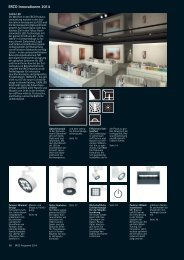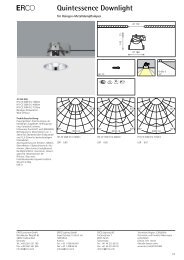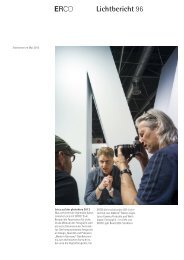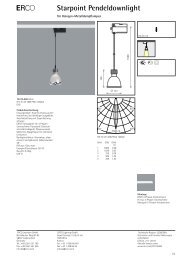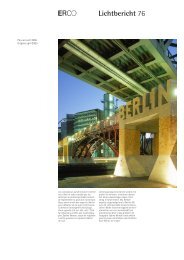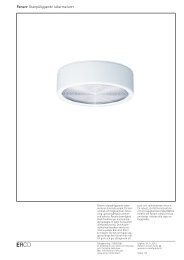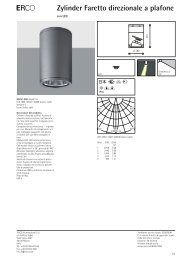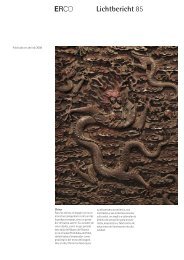Vertical Illuminance - Erco
Vertical Illuminance - Erco
Vertical Illuminance - Erco
Create successful ePaper yourself
Turn your PDF publications into a flip-book with our unique Google optimized e-Paper software.
The wall lighting in the<br />
indoor area is continued<br />
outside: the grazing<br />
lighting on the wall and<br />
the illuminated wall of<br />
trees both add to the<br />
emotive ambience on<br />
the terrace.<br />
Designing vertical illuminance<br />
External areas<br />
The lens wallwasher’s<br />
asymmetrical light distribution<br />
is ideally suited<br />
to facade lighting.<br />
The light distribution<br />
avoids spill light straying<br />
upwards, enabling<br />
“Dark Sky” lighting<br />
solutions to be implemented.<br />
Nocturnal facade lighting presents cities, local<br />
authority districts and private clients with a<br />
multitude of design possibilities for lighting<br />
both individual buildings as well as groups<br />
of buildings in the context of public squares,<br />
courtyards or main roads. The spectrum ranges<br />
from simple lighting intended primarily<br />
to provide orientation and safety, through to<br />
presentational lighting solutions and scenic<br />
illumination for special occasions. For buildings<br />
that are visible from afar, such as skyscrapers<br />
or towers, vertical lighting has the<br />
important task of highlighting nocturnal landmarks.<br />
Where buildings around the edge of<br />
public squares are concerned, facade lighting<br />
helps to ensure that these buildings are recognisable<br />
after dark and promotes better spatial<br />
understanding.<br />
In the interest of a “Dark Sky”, the lighting<br />
designer can effectively avoid what is known<br />
as light pollution (i.e. light which is emitted<br />
directly into the night sky) by using highquality<br />
lighting technology and by arranging<br />
the luminaries appropriately.<br />
The texture of basreliefs<br />
on facades and<br />
of other material features<br />
can be enhanced<br />
by the shadow effect<br />
of wallwashing.<br />
Many monuments and historical buildings tell<br />
their story in bas-reliefs, ornamentation or<br />
sculptural decoration. It is only with light and<br />
shadow that the three-dimensional nature<br />
and texture of the surfaces can be appreciated.<br />
Architectural details such as the constituency<br />
of materials, joints or facade patterns<br />
are also amongst those important features<br />
which, when discernable, will characterise the<br />
appearance of a building or structure at night.<br />
The contrast on the surface can be influenced<br />
by the direction of the light and the<br />
type of luminaire. Moving a floodlight further<br />
away from the facade gives the surface a uniform<br />
but flat appearance because the formation<br />
of shadows is reduced. Conversely, luminaires<br />
positioned right next to the facade will<br />
produce extreme shadow, creating a dramatic<br />
impression. A mid-way position, as is the norm<br />
for wallwashers, gives a balanced appearance<br />
with an even light distribution on the surface,<br />
while still allowing the three-dimensional<br />
nature of any details to be easy to recognise.<br />
Correction filters alter the colour impression<br />
for certain ranges of colour only. Thus,<br />
for instance, the warmer tone of the Skintone<br />
filter can emphasise the colour of beige sandstone.<br />
When using coloured light, a nocturnal<br />
perception and atmosphere is created which<br />
is distinct and independent from the daytime<br />
appearance. Certain moods and contrasts can<br />
be created with coloured light, and these can<br />
be used for instance to delineate large facade<br />
surfaces or to distinguish different parts of a<br />
building from each other.<br />
8 9



